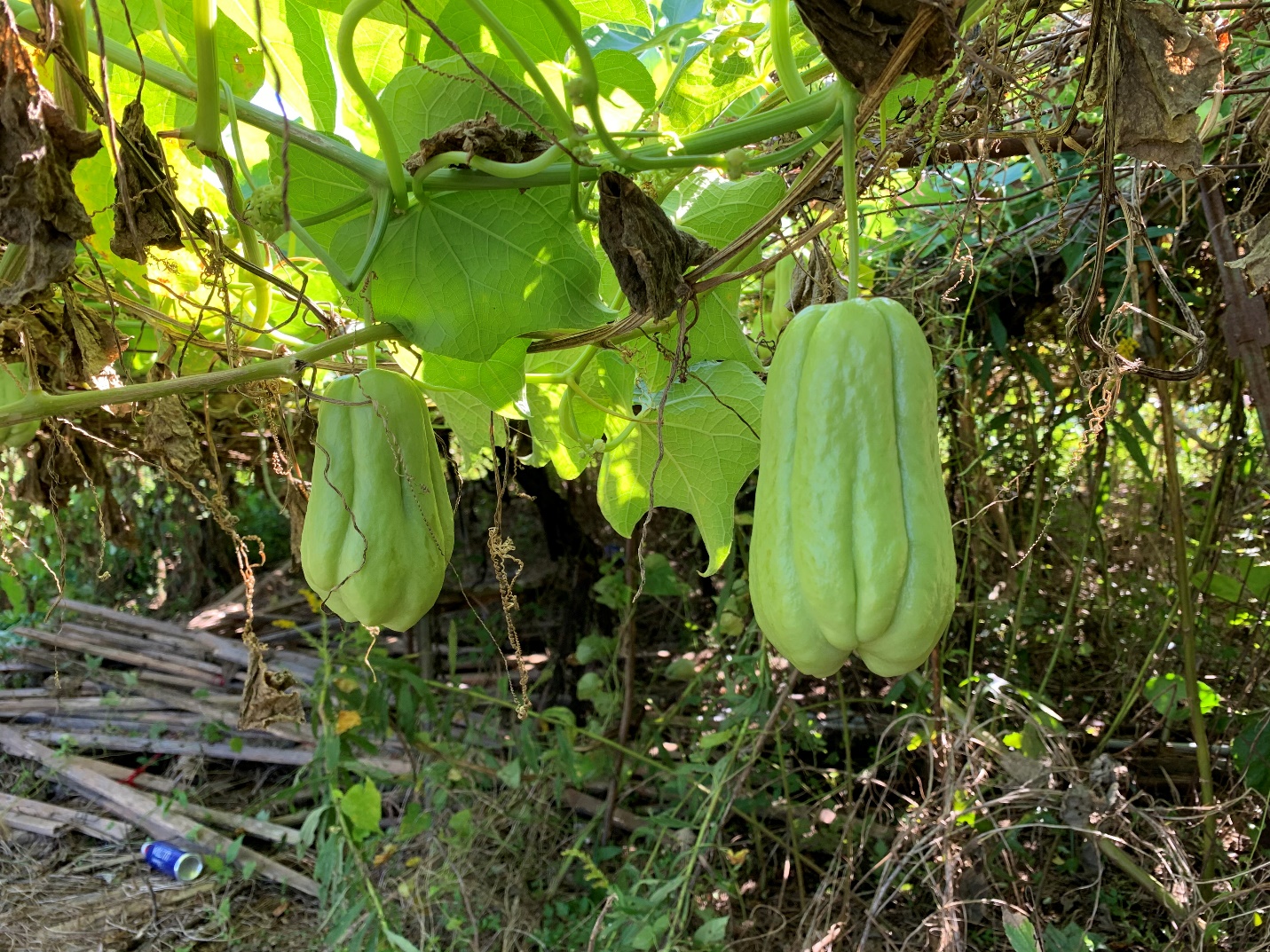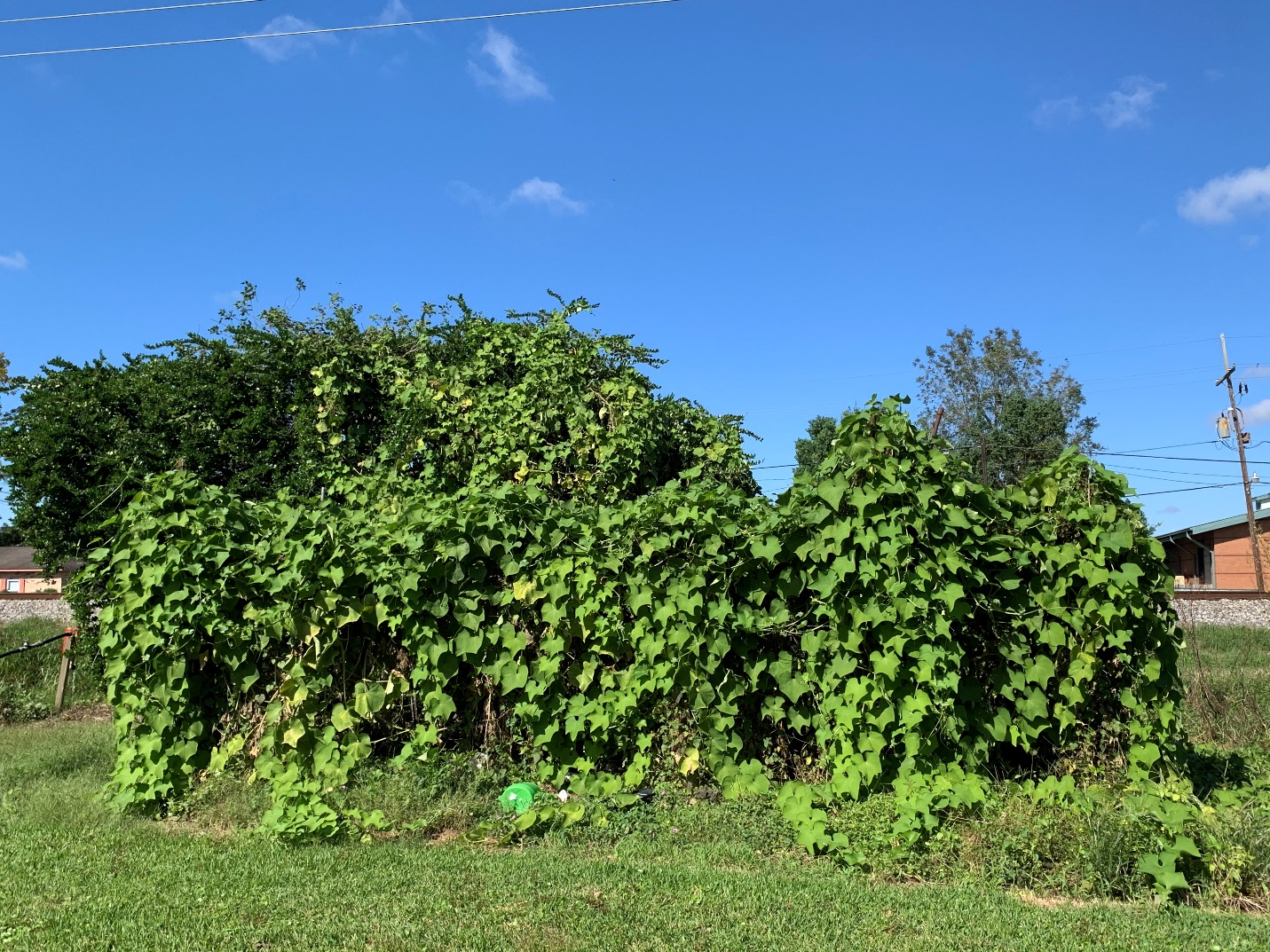by Lance Hill | Nov 24, 2020 | Mirliton
Old Family Tradition of Mirliton Growing Flourishes in St. John Parish
By Renee Lapeyrolerie and Dr. Lance Hill
First, a little genealogy. In the 1970s, Joseph “Junior” Remondet started his first mirliton (chayote) vine in Reserve, St. John the Baptist Parish in Louisiana. Remondet’s uncle had handed down the old family variety that they had for generations. Junior shared it with his bother-in-law and next-door neighbor, Earl Perque, who bequeathed it to his son Paul Perque It’s a bit like the begats in the bible, but Louisiana mirliton growers believe in preserving family traditions.

Figure 1 Remondet-Perque Heirloom Mirliton
Mirlitons are in the Remondet-Perque family’s genes. The family has grown them for generations. Junior Remondet is a big, garrulous man with a thick Louisiana French accent. His uncle told him to plant two mirliton seeds in keeping with an old myth that you need a male and female plant; but it was good advice since it doubled his chances of success. The family heirloom mirliton is now primarily in the care of Paul Perque. The trellis 15′ X 10’ and is made of fence posts and covered on top with livestock panels (4”x4” mesh) and receives full sun.

Figure 2 Joseph ‘Junior’ Remondet, Paul Perque, and Ryan Remondet.

Figure 3 Paul Perque with his current vine, has yielded over 300 mirliton at publishing.
Paul Perque’s late mother, Sylvia, took careful notes of the harvest in the back of her address book. Her records include years of family and friends who would call and request mirliton for purchase by the dozen to make stuffed mirlitons. Miss Sylvia was a great cook, known for making pastries for the local church and school.

Figure 4 Sylvia Audiffred Perque’s family notebook of 2013 Mirliton Harvest.
Ryan fondly remembers helping his father tend to the mirliton trellis, running new wires across the top. Ryan is in the grocery produce business and recounts when a colleague from the West Coast visited him and was mystified by the enormous quantity of chayote coming into Louisiana since there were few of the Latino and Asian populations that valued the squash. Ryan told him the history of home growing mirlitons in Louisiana. For the coup de grace, he had his mother prepare his colleague some of the traditional shrimp-stuffed mirlitons.

Figure 5
The vine is located at the end of the family lane and adjacent to a large drainage ditch alongside the Canadian North Railroad. Junior’s uncle had suggested that he plant near a water source such as this, and Paul credits the vine’s success to this location.
The vine has a traditional Louisiana overhead trellis (arbor) and access to an adjacent tree that it likes to climb. In 2019, an early frost—the first in over a century—killed the top of the vine but it recovered and regrew in the spring of 2020.

Figure 6 Full Vine.

Figure 7 Earl Perque with his mirliton vine in background.

by David Hubbell | Nov 13, 2020 | Mirliton
Update on the Ishreal Thibodeaux White Mirliton Preservation Project – October 2020
By David J. Hubbell
Background:
On June 20th, 2020, Mirliton.org announced the we were kicking off the Ishreal Thibodeaux White Mirliton Preservation Project in an attempt to bring back, from the brink of extinction, this rare ivory white variety of the mirliton grown and cared for over four decades by Opelousas, Louisiana’s Ishreal Thibodeaux. If you haven’t already check out the Update on the Ishreal Thibodeaux White Mirliton Preservation Project – July 2020 or August/September 2020 please do so here: https://www.mirliton.org/2020/08/10/update-on-the-ishreal-thibodeaux-white-mirliton-preservation-project-july-2020/ or here https://www.mirliton.org/2020/09/26/update-on-the-ishreal-thibodeaux-white-mirliton-preservation-project-august-september-2020/. They contain an in depth look at all of our growers and efforts from the start of the project.
Reports from the Field:
The month of October was a one in which we expected to start seeing some rapid fruiting of the Ishreal Thibodeaux Mirlitons. While the weather was cooler, the Gulf Coast was again rocked by another set of hurricanes with Delta and Zeta making landfall in October. Luckily, our growers didn’t sustain any issues.
Starting with the Carolina growers we learned the following:
Chris Smith’s reported that “I’ve taken cuttings to root out and sent one to a greater greenhouse in CLT. I’ve got mine under cover and will overwinter. The main difference in learning is that my vines will flower and fruit in fall when the daylength drops, yours will flower and fruit in spring when it warms. If they survive the winter here, I’ll plant out next May and hope to get to fruit that fall. I may try to force flowering with daylength restrictions.” To note: the Ishreal Thibodeaux will actually flower and fruit in both the fall and spring in an established vine. Chris’s information and hopeful success on taking cuttings and overwintering will be of great interest to us in the future months on

Image 1. The first of two potted mirliton Chris Smith and his group are nurturing.

Image 2. Another view of Chris Smith’s potted mirliton.
By mid-October, Keith Mearns plants were also doing well in Columbia, South Carolina. He sent updated pictures of the one in the ground as well as one in the pot (see below). In addition, he had successfully started one from a cutting. He reports
“…I had success with cuttings with at least three nodes, cut end dusted with Hormodin 3, inserted into 100% perlite, kept under mist (3min every 45 min) “. This is very encouraging as it gives us a second way to preserve this and other mirliton plants other than simply starting them from seed mirliton! This is definitely something we hope to explore further and share with the Mirliton.org community in the future.

Image 3. Keith’s mirliton cutting. This looks to be doing well!

Image 4. The first of potted mirliton Keith Mearn’s is nurturing.

Image 5. Keith’s planted mirliton has seen some substantial growth since last month!
James Cobb’s vines in Houma was also doing well in mid -October with the emergence of several new tendrils.

Image 6. James’ potted mirliton doing well in October.
In addition to just the propagation of the plant, Dr. Lance Hill and I worked with a Baton Rouge area designer to come up with a Team shirt to also propagate awareness. We have elected James our “poster boy” due to the joy in his face as he sports this new shirt. (More to come on this below).

Image 7. James sporting the new Ishreal Thibodeaux White Mirliton Preservation Project Tee next to his potted mirliton.
Metairie grower Paul D’Anna reported that his vine is still surviving, but was struggling. However, he noted that one of the unofficial growers he had previously given an Ishreal Thibodeaux vine to was seeing some tremendous success. We will follow up and see if they are willing to participate in the official project.
Some exciting news from Chef John Folse was that once again he was producing some nice sized Ishreal Thibodaeux mirlitons. He reported early in the month that, “Today at White Oak Estate & Gardens in Baton Rouge, I picked seven of the largest Ishrael Thibodaux White Mirliton I’ve ever grown! For some unknown reason, this Fall season is producing some of the most unbelievable white mirliton I’ve seen both in size and quantity. Might be the rabbit cages next to the arbor!!!!!”

Image 8. John Folse’s older vine is starting to produce in Baton Rouge.
By October 26th, Chef John reported the following. “Counted 36 mirlitons on the vine today…WoW! … I’ll pick about 6-8 very large ones to add to the 5 large ones picked yesterday.”

Image 9. Chef John Folse showing the bounty from his harvesting of mirlitons at White Oak Estates and Gardens in Baton Rouge.
“How big is that mirliton?” you’re asking. It measured 12” diameter and 1.113 pounds!

Image 10. The Ishreal Thibodeaux White Mirliton picked from White Oak Estates & Gardens is definitely a keeper.
From my end, the one I received from Chef John was plant in Mobile and is doing well, though I don’t expect to see any fruiting until the spring.

Image 11. David Hubbell’s mirliton slowly adjusting to being transplanted in Mobile.
Closing Thoughts for Effort So Far:
This third update hopefully showcased the fruits of the efforts so far. As I write this in mid-November, we know that the yields we are seeing so far aren’t as great as we had hoped, but if we can preserve these vines through another growing season, we should have an even better spring than we saw this year. Right now, I am thinking of maybe only have a smaller set of additional growers, say maybe two more to overwinter a few and plant in the spring. I will go through the list of previous applicants and narrow down the field to between 2-5 to be prepared. More to come in the next few weeks.
For information on the tee shirt James was wearing, please click on this link to take you to detailed information on how to get one. – Mirliton Tee.
If you have any comments, questions, or suggestions, please send them to me David J. Hubbell at rpcajun2r@gmail.com. Thank you.



















Recent Comments